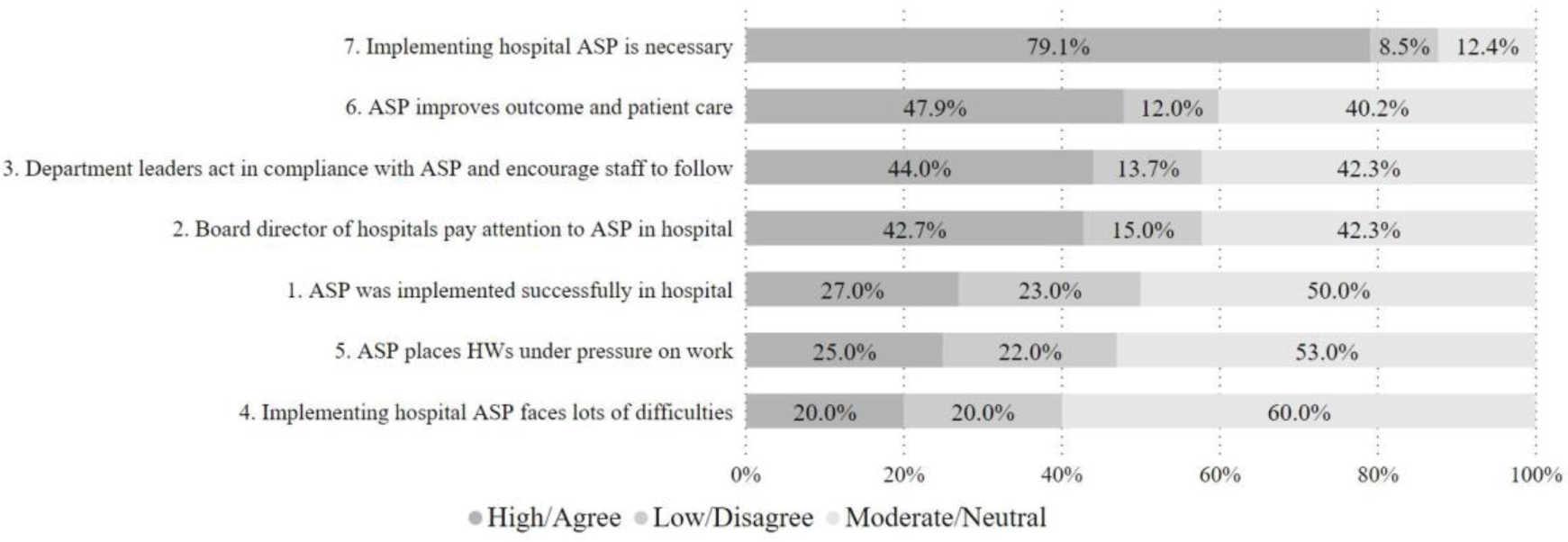1. INTRODUCTION
Antimicrobial resistance has become an urgent worldwide issue, especially in developing countries. According to the Centers for Disease Control and Prevention (CDC), Vietnam is one of the countries having the highest rates of antimicrobial resistance and multiple drug resistance, which causes thousands of deaths annually, among Asian countries. This region has recently tackled the serious antimicrobial-resistant infections in bacteria commonly associated with hospital-acquired infections, malaria and tuberculosis [1]. This is due to the tropical climate that promotes bacterial growth and the ineffective implementation of infection control and antibacterial use management. Accordingly, a study conducted in 36 general hospitals indicated that approximately one-third of the inpatients had an inappropriate antibiotic prescription [2]. To reduce antibiotic resistance, people should use antibiotics prudently based on guidelines of the antimicrobial stewardship program (the ASP) [3]. Hence, since 1950, many countries have implemented the ASP, namely the Hammersmith Hospital (London, England) in 1957 [4]. In Vietnam, until 2016, the Ministry of Health instituted a “Manual on the management of the use of antibiotics in hospitals” aimed to optimize antimicrobial drugs use, decrease the adverse drug reactions, improve patient care, prevent antimicrobial resistance and reduce medical expenses [5]. Despite nearly 3 - year of implementation, an operational situation of the hospital ASP is still open. Besides that, Ho Chi Minh City (HCMC) is one of the biggest cultural and economic centers in Vietnam which has various types of hospitals to receive both emergency or non-emergency patient transfers and referrals from the south of Vietnam. Hence, this study was conducted to assess the implementation status of the ASP in hospitals administrated by the HCMC Department of Health and to explore the health workers’ perception of this implementation.
2. MATERIALS AND METHOD
We conducted this cross-sectional study using a self-administered questionnaire to investigate the viewpoint of health workers (HWs) who took part in the training course at the Hospital for Tropical Disease in HCMC in July 2019. We constructed the questionnaire based on Decision 772/QD-BYT to scientifically evaluate antibiotic prescribing rationalization regarding various aspects. We collected data by training course participants using a convenience sampling method and written informed consent was obtained from the participants. The HCMC Department of Health Research Ethics Committee approved the study (Approval Number: 2377/KH-SYT).
This study analyzed the operational situation based on 6 core elements: (i) Leadership support (Document and financial aid); (ii) Accountability (Physician, pharmacist and other HWs); (iii) Actions to support optimal antibiotic use (Policies, broad interventions, pharmacy-driven interventions and diagnosis and infections specific interventions); (iv) Tracking: Monitoring antibiotic prescribing, use and resistance (Process measures, antibiotic use and outcome measures and monitor antibiotic use); (v) Reporting information to staff on improving antibiotic use and resistance; (vi) Education
We performed these measures on Yes/No scale and used descriptive statistics to describe number/frequency (n) and percentage (%) of data. We also took the average of items in each element to calculate the score of each core element.
The experts designed a 3-Likert scale questionnaire comprising 7 questions (variables) was designed to analyze the HW’s attitude towards the hospital ASP. This study performed an exploratory factor analysis (EFA) to determine the structure and then classify variables. Before conducting EFA, we carried out the Bartlett test and KMO test to ensure the condition of conducting EFA and thereafter used the parallel analysis to ascertain the number of factors.
This research used the Chi-square test and Fisher test to determine whether there is a significant difference between answers of participants involved/uninvolved in the ASP team and among answers of different class hospital groups. A p<0.05 was a statistically significant difference. We used R Version 3.6.1 and Microsoft Excel Version 2016 to carry out all analyses.
3. RESULTS
This study included 234 HWs and the gender distribution was relatively equal (123 females made up 52.7%). The majority were in the 30 to 50 years-old group (61.3%). In most of the demographic characteristics, there were no significant differences between two groups of HWs: HWs involved in the ASP team and those who were uninvolved in the ASP, except profession and healthcare sector. Physicians (81.8%) and the clinical sector (73.7%) were most uninvolved participation rates in the ASP team (Table 1).
Table 2 shows that the percentage of hospitals of which board of directors has provided a formal, written statement to support the hospital ASP was high (74.8%), whilst only 23.1% of hospitals received the financial support for antibiotic stewardship. There was a high proportion of hospitals that held a physician leader and a pharmacist leader responsible for the program while the majority of 3rd, 4th hospitals have been lacking accountability. Most of the surveyed hospitals took actions to optimizes antibiotic use and the statistically significant difference between different hospital’s classes was determined, especially in 2nd, 3rd and 4th class hospitals. Although most of the surveyed hospitals have audited the policy adherence, the number of hospitals monitoring antibiotic use and resistance was relatively low, especially in tracking rates of Clostridioides difficile infection (23.5%) and producing an antibiogram (47.4%). Furthermore, there is no statistically significant difference between the answers of different groups. The proportions of hospitals that have reported information to staff on improving antibiotic use and resistance were not high and there is a statistically significant difference between answers of the members involved in the ASP team and uninvolved in the ASP team about sharing facility-specific reports and having a current antibiogram. Most hospitals have provided education about antimicrobial stewardship for HWs, which corresponds with a percentage of 67.9%. Nevertheless, this figure represents difference among the hospital class groups. Particularly, 3rd and 4th class hospitals have the least organizing training course proportion (59.3%).
The results of the Bartlett test (p < 0.001) and KMO (0.8) demonstrated that EFA is well fit for the analysis. Most HWs thought that implementing the ASP in hospitals is necessary (79.1%). The EFA results divided 7 questions into 3 factors. In particularly, factor 1 (contained question 1, 2, 3) and factor 3 (contained question 4, 5) had a higher loading factor (0.5) compared to factor 2 (Figure 1).
4. DISCUSSION
There was a similarity between this study and a statistical report in terms of the distribution of HWs in different hospital classes [6]. Since most of the participants were physicians (69.7%) and pharmacists (29.5%), this result was consistent with the fact that, in hospitals, physicians and pharmacists are responsible for the ASP [7-9].
This study constructed the checklist based on the Decision 772/QD-BYT (2016) which closely corresponds to the “Core Elements of Hospital ASP” launched by the CDC and other studies in developing countries all over the world [10-12]. However, in the latest publication of the CDC (2019), the element “Leadership Commitment” reinforced (i) the human resource, (ii) information technology (IT) support, and (iii) leader having regularly scheduled meetings [13]. The updated assessment tool eliminated the key groups supporting the ASP in the checklist. Instead, the guideline indicated the role of other groups and departments in the hospital in enhancing the ASP [13]. Furthermore, leading pharmacists should receive specific training and/or possess experience in antibiotic stewardship [13]. In addition, the facility should add specific criteria to ensure optimal use of antibiotics in some diseases such as sepsis, Staphylococcus aureus infection, stopping unnecessary antibiotic(s) in new cases of Clostridioides difficile infection.
In brief, the assessment made by HWs illustrated that the effectiveness for the implementation of the ASP in hospitals was above average (62.7). Particularly, “leadership support”, “accountability”, “actions”, “tracking”, “reporting”, “education” reached a score of 49.0, 78.2, 69.6, 54.0, 57.7, and 67.9, respectively. However, these results may contain certain errors due to the significant differences between answers of participants involved in the ASP team and those uninvolved in the ASP team about supporting documents, accountability, dose optimization, and report sharing. This difference also showed that there was a lack of conveying the ASP information to HWs in hospitals. Furthermore, the status of the ASP implementation drew from this study shared a lot of similarities with the results of a study conducted in Karachi-Pakistan [12]. Nevertheless, the ASP in hospitals administrated by the HCMC Department of Health was more strongly supported by the board director of hospitals than hospitals in Pakistan, especially in documents, and accountability to clinicians and pharmacists. Besides, a low score in leadership support (49.0%) was principally due to the absence of financial support (23.1%).
This research also indicated that the barrier which may deter the hospital ASP consisted of deficiency in finance, the guideline of diagnosis and specific interventions for some common infections, distributing current antibiogram and monitoring rate of Clostridioides difficile infections. However, many studies also reported that these elements have been widely considered as major deterrents in implementing the ASP [12, 14-16].

There was a statistically significant difference between answers of different class hospitals, namely action to support optimal antibiotic use, diagnosis and interventions, antimicrobial resistance report. Especially in 3rd, 4th class hospitals, these proportions of implementing these elements were relatively low because of variation in resources. Hence, it is necessary to pay attention to supporting these hospitals in implementing the ASP.
The study recorded feedbacks for suggestions on improving the quality of training (22 opinions), namely “expand the training course and develop specific training topics”. In particular, four areas of knowledge are interested in participating are (1) Guideline of treatment/prophylaxis (79.9%); (2) How to implement the ASP (55.6%); (3) Clinical pharmacy (51.1%) and (4) Clinical microbiology (35%). Moreover, there were 14 opinions on “Construction guideline and accountability” to improve the ASP.
Most of HWs in the survey (79.1%) agreed that implementing the hospital ASP is necessary. However, when asking about the current operational situation, most of them had no comment (40-60%). This might be due to objectivity in the questionnaire being asked, thus it was difficult for participants to have answers. Therefore, to provide useful information for studies in the future, we extracted 3 factors from EFA and name these (1) Leadership; (2) Implementation difficulty; (3) The ASP’s outcome. These factors were closely related to facilitators of studies in other developing countries [14, 15].
To our knowledge, this is the first study identifying the operational situation of implementation of the ASP in some hospitals administrated by HCMC Department of Health, hence, there are certain limitations. Firstly, we built the checklist based on Decision 772/QD-BYT and subjective opinion of experts, so we have shown the issues needed to be edited. Secondly, this study collected the sample by the convenient sampling method which might cause errors in generalizing the situation of the ASP implementation in HCMC.
5. CONCLUSION
The state of the ASP implementation at some hospitals in Ho Chi Minh City is preliminary at an above-average level. Despite the support of the leadership, the implementation of the ASP still faces many difficulties and limitations, especially in the 3rd and 4th class hospitals. Also, there was a deficiency in the propagation of information on the ASP at each unit. This has led to discrepancies in information deployment between HWs in the ASP team and the non-ASP HWs. Moreover, experts should issue more guidelines on treatment/prevention as well as diagnosis/treatment methods of various common infections in hospitals. To generalize the status of the ASP implementation, researchers should conduct a study combining qualitative and quantitative methods with a larger scale soon.








